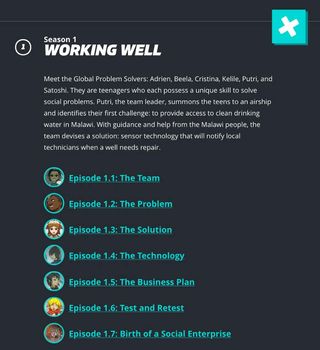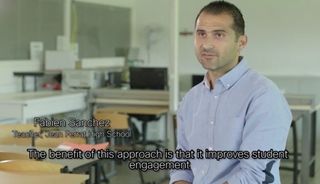
We want our kids to help lead their own learning, have the soft skills to work well with others, be engaged with their communities, and solve authentic problems.
So basically . . . kids who grow up to save the world. No biggie.
Producing those kinds of kids has never been easy. But it may have just gotten a little easier. During a short conversation yesterday with Robi Alstrom, ESSDACK ELA superstar, she shared a new tool with me that looks like a winner.
Created by Cisco, the Global Problem Solvers is designed to introduce middle-to-high-school students to social innovation with a particular focus on how they can use technology to create effective solutions to seemingly unsolvable problems. The series of videos, engaging characters, and teacher resources provide students with a basic set of problem-solving tools for turning their visions for change into a practicable reality. So you get a handy little tool perfect for starting conversations around civic engagement and turning those conversations into actual plans.
Social innovation is a relatively new phrase that is finding its way into education circles. The short version? Social innovations are strategies and ideas that aim to address social needs resulting from working conditions, education, community development, and health. Innovations are created with the goal of extending and strengthening civil society.
The concept connects cleanly into our state’s call for getting kids out into their communities and impacting change. Most of you outside of Kansas are probably experiencing the same. GPS seems like a great structure for embedding Project-Based Learning, civic engagement, community service, soft skills, social/emotional needs into your instruction.
Of course, blending all of that together is when things can get a bit messy. This is where the Global Problem Solvers stuff can come in handy. The GPS series engages students with the story of how a global and diverse teen super-team takes action against the problem of safe water shortages in developing communities. The series encourages students to think of social entrepreneurship not just as an inspiring ideal, but as an achievable goal.
The goals of GPS are:
- Foster an entrepreneurial approach to problem solving;
- Encourage the future development of innovative technological solutions and sustainable social ventures;
- Inspire students to be social change agents; and
- Facilitate the achievement of these objectives by presenting six attributes of Global Problem Solvers and nine steps of social entrepreneurship in an engaging and entertaining way.
The fictional members of the Global Problem Solvers super-team, their home countries, and the attributes they exemplify include:
- Beela, Jordan
Digital skills – Not just using technology, but embracing it. People who can
analyze data, build networks, develop apps, or secure devices can bring ideas to life. - Adrien, France
Creativity – Dreaming up new ways to solve problems and make things better
for others. Innovative ideas are the foundation for addressing the challenges we face. - Satoshi, Japan
Critical thinking – Analyzing one’s way around every obstacle. People who are
curious, ask questions, and evaluate options are essential to solving problems. - Kelile, Malawi
Social consciousness – Awareness that “changing the world” is a must and that
everyone can make a difference. People with a sense of service inspire others and spark transformation. - Cristina, Brazil
Entrepreneurial spirit – Seeing a challenge as an opportunity waiting to
happen. People who are comfortable taking risks and leading others can turn ideas into action. - Putri, India
Teamwork skills – Communicating well and respecting others. The best problem
solvers realize they are stronger working together than powering through alone.

There are two video series that highlight two different issues around water. The first, not enough as the team tackles broken wells in Malawi. The second, too much as they deal with hurricane damage in an urban Florida area. Kids watch short video clips of the super-team in action and then you facilitate discussions, activities, and strategic planning.

You get an extensive Teacher’s Guide with guiding questions, handouts, and actual examples of real kids around the world solving authentic problems. You also get access to video storyboards and scripts that can help you use the videos more effectively. (Perhaps as examples for kids who want to create their own videos.) The key here is to find ways to move beyond the theoretical and into the actual communities your kids live in.

The target audience seems to be the 5-9 grade range but it would be relatively easy to adapt the resources up or down depending on your content and grade level. There’s also a GPS blog that provides tips, tricks, and links to other teachers using the series.
There’s also a great video from a school in France on the Teacher page that you should start with, highlighting what using the tool can look like. Then download all the PDFs.


Here are a few sample questions that the guide uses to spark discussion:
- What social problems do the students encounter in their own communities or home country?
- What problems do students see that point to bigger problems to be solved?
- Might there be any hidden problems—things that everyone accepts as normal but actually could be improved?
- How would the students go about finding more information about how they can help?
It’s free. Got some great resources. Seems engaging to its target audience. And addresses the need to help kids find ways for connecting with authentic needs in their communities.
cross posted at glennwiebe.org
Glenn Wiebe is an education and technology consultant with 15 years' experience teaching history and social studies. He is a curriculum consultant for ESSDACK, an educational service center in Hutchinson, Kansas, blogs frequently at History Tech and maintains Social Studies Central, a repository of resources targeted at K-12 educators. Visit
glennwiebe.org to learn more about his speaking and presentation on education technology, innovative instruction and social studies.
